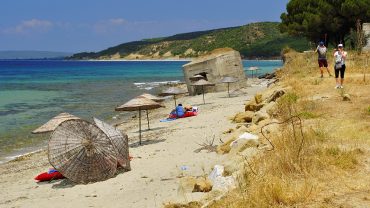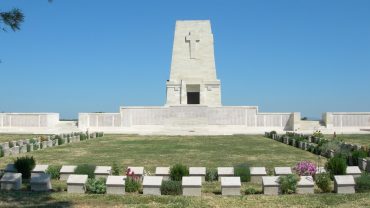As the sun rises over Anzac Cove in Gallipoli on the 25th April this year, Australia and New Zealand will remember this day, one hundred years ago, when the Anzacs, the Australian and New Zealand Army Corps, landed at Gallipoli.

Remembering Anzac Day
Many Australians visit Turkey and many make the pilgrimage to Gallipoli to Remember Anzac Day. Is this because of our sense of duty or is it because as we get older, we realise that the history of our country is important? For me it was a mix of both.
As schoolchildren, Anzac Day was important to us for one reason…a day we didn’t have to go to school! We knew the history but we could not relate to it.
As we got older we may have attended an Anzac Day service in our home town. In the last few years there’s definitely been an increase in the number of people attending Anzac Day services, especially amongst the younger generation.
As we travelled……
In 2013, we attended the Anzac Day Dawn Service at Villers-Brettoneux. With the sun slowly rising over the war memorial, the sound of the lone piper and the speeches citing excerpts of letters from those in the trenches, a scene was set that we had never imagined.

A day spent driving around the beautiful Somme area, the hills dotted with thousands of white crosses and war memorials recording the many names of those who lost their lives, very quickly made us realise exactly the price that was paid by so many young men.

Centenary celebrations for Anzac Day actually started last year. On Nov 1st 1914, troop ships carrying Australia’s soldiers left Albany in Western Australia for Europe. Visiting this memorial and reading comments from those who were on the boats added to the realism of the situation.
With all of this, we felt that the time had come to finally visit Gallipoli.
Our ferry from Greece took us to Kusadasi and from there we drove via Ephesus and Alaçati to Canakkale and finally by ferry to Eceabat.

We had not arranged a guide to tour the battlefields of Gallipoli but by coincidence there was a tour group meeting at our first stop. I chatted to the tour leader, asking which company he was from. In my years as a travel agent we had used a specific Turkish/Australian tour guide for clients who wanted to visit Gallipoli. He was from the same company we used but you can imagine my surprise when he told me his name. He was the owner of the company that we had always dealt with. What a coincidence….it was like meeting a long lost friend! We then joined his tour of the area which gave us a far greater insight to the history that we would otherwise have had.
Highlights of Gallipoli
Beach Cemetery

This cemetery marks the southern end of Anzac Cove and a point known as Hell Spit. The most famous grave here is that of John Simpson Kilpatrick of ‘Simpson and his donkey‘ fame
Private John Simpson Kilpatrick was killed by shrapnel on May 19 aged 22 years. He had been in Gallipoli for only 25 days but in that time he and his donkey had carried 202 wounded men back to the medical stations.
Not far from here, a path leads you to Shrapnel Valley and onto Monash Valley. Shrapnel Valley was the main route that the troops took to get to from the beach to the frontline. Once the Turks realised this it became a dangerous path to take. It was along these paths that Simpson and his donkey carried many wounded. It was also here that he met his death.
Anzac Cove

The site of the first landing of the Anzac troops on 25th April 1915 is marked by a solitary wall bearing the words Anzac Koyu/ Anzac Cove. Here twelve hundred soldiers from the 9th, 10th and 11th Battalions of the 3rd Australian Infantry Brigade were first ashore. Unfortunately they were supposed to have been a kilometre and a half further south but the boats lost their way in the dark. They were met with heavy gunfire from the Turkish.

Our guide had a photo of how the beach looked at this time which we compared to now. 100 years ago the beach was 600 metres long and 20 metres wide but erosion has now reduced it by 30-40 metres.

Kabatepe Ari Burnu Beach Memorial
Those heroes that shed their blood, and lost their lives …
You are now lying in the soil of a friendly country.
Therefore, rest in peace.
There is no difference between the Johnnies
And the Mehmets to us where they lie side by side,
Here in this country of ours.
You, the mothers, who sent their sons from far away countries …
Wipe away your tears.
Your sons are now lying in our bosom and are in peace.
After having lost their lives on this land, they have
Become our sons as well.
These poignant words, written by Mehet Kemel Ataturk in 1934, were sent to the first officials of the Allied Forces to visit Gallipoli after the First World War. The memorial on which they are written is close to the sight of the first Gallipoli landing on April 25th 1915…

Ari Burnu Cemetery
At the northern end of Anzac Cove is Ari Burnu (Bee Point) Cemetery. On that fateful day, troops landed all along this stretch of water and faced the task of trying to head to Chunuk Bair, the highest point near here.
Many met their death here and are buried in the cemetery where two large oak trees, symbols of long life, stand majestically over the graves.

I went down and stood on the beach, thinking of those who were on of the first boats to come ashore. According to Charles Bean, Australia’s war correspondent at the time, they quickly realised they were in the wrong place but had to proceed up the beach. A call to retreat was requested a few days after the landing but was denied. The rest is history.

Anzac Commemorative Site

The commemorative site was moved to this position on North Beach in 2001 so more people could be accommodated for the dawn service. This year it will see the most people it has ever seen with 10,500 people attending the dawn service.

If you stand with your back to the sea, you can see one of three high ridges that faced the soldiers. Having come from training camps in Egypt, they quickly nicknamed this ridge the Sphinx…a perfect named as you can see!

Turkish Soldier

On the road to Lone Pine, you will pass a statue that depicts a turkish soldier carrying and Anzac soldier.
The scene is supposedly inspired by a story told by Lord Casey, who was once Australia’s Governor General. The story tells the tale of the Turkish soldier raising a white flag and then getting out of the trench and carrying the injured Anzac soldier to the Allied trenches. This has not been confirmed and there are many variations of the story told but the gesture is memorable.
Lone Pine Memorial

Lone Pine is the site of the Australian War Memorial. Australian Anzac Day memorial services take place here each year. It is one of the memorials that Australians visiting Gallipoli ensure they visit.
Over three days in August, in a very small area and with opposing trenches only metres away from each other, 2000 Allied soldiers and 7000 Turkish soldiers lost their lives. Seven Victoria Crosses were award to our soldiers at this, one of the hardest battles of the war.

The lone pine tree that stands here today was grown from seed after the original was destroyed early on in the battle and its replacement was burnt in a fire. The story tells of a soldier who found a pine cone on his dead brother and sent the cone back to his mother as a memento. Seeds were taken for this cone for a pine tree in Canberra and Albany and for the replacement tree in Turkey.
It was here that I found the headstone for 16 year old Private O’Donnell who had runaway to join the army. So young.

Alay Turkish Cemetery.

We also stopped at this Turkish cemetery that remembers the Turkish 57th regiment, led by Mustafa Kemel (Ataturk)
The 57th regiment were fighting at Chunuk Bair when Ataturk gave his famous order:
“I am not ordering you to attack, I am ordering you to die. In the time if takes us to die, other troops and commanders will arrive to take our places”.
Chunuk Bair Memorial

One of the first objectives for the ANZAC troops when they landed at Gallipoli was to take control of Chunuk Bair, a high point overlooking Gallipoli.
New Zealand lost many troops in one of the most ferocious battles of the war. Approximately 30,000 troops died here over a period of 4 days in August 1915 and it is here that the New Zealand war memorial remembers those who died.


It is also the site of a statue of Mustafa Kemel Ataturk.

Ataturk gave his famous order here as the first wave of the Anzac troops made their way to the point on April 25th. Turkish leaders did not believe that the allies would traverse the steep slopes surrounding this point but Ataturk did and organised for his troops to be waiting.
Brighton Beach

From here we headed back to Brighton Beach, our starting point of the tour and the beach where the ANZACs were supposed to have landed.
I wonder how history would read if they had been on course and landed here instead of Anzac Cove.
Where to stay:
Eceabat is the closest town to the Gallipoli sites
We chose to stay at Hotel Casa Villa, a very clean B&B close to the town.
Book Hotel Casa Villa here
Though it was fully booked when we wanted to visit, my first choice would be The Gallipoli Houses which is in a small village between Eceabat and Gallipoli.
Where to Eat:
Liman Restaurant
Istiklal Caddesi 67, Eceabat
Excellent seafood






Comment (0)